Renjing Pei
PMQ-VE: Progressive Multi-Frame Quantization for Video Enhancement
May 18, 2025



Abstract:Multi-frame video enhancement tasks aim to improve the spatial and temporal resolution and quality of video sequences by leveraging temporal information from multiple frames, which are widely used in streaming video processing, surveillance, and generation. Although numerous Transformer-based enhancement methods have achieved impressive performance, their computational and memory demands hinder deployment on edge devices. Quantization offers a practical solution by reducing the bit-width of weights and activations to improve efficiency. However, directly applying existing quantization methods to video enhancement tasks often leads to significant performance degradation and loss of fine details. This stems from two limitations: (a) inability to allocate varying representational capacity across frames, which results in suboptimal dynamic range adaptation; (b) over-reliance on full-precision teachers, which limits the learning of low-bit student models. To tackle these challenges, we propose a novel quantization method for video enhancement: Progressive Multi-Frame Quantization for Video Enhancement (PMQ-VE). This framework features a coarse-to-fine two-stage process: Backtracking-based Multi-Frame Quantization (BMFQ) and Progressive Multi-Teacher Distillation (PMTD). BMFQ utilizes a percentile-based initialization and iterative search with pruning and backtracking for robust clipping bounds. PMTD employs a progressive distillation strategy with both full-precision and multiple high-bit (INT) teachers to enhance low-bit models' capacity and quality. Extensive experiments demonstrate that our method outperforms existing approaches, achieving state-of-the-art performance across multiple tasks and benchmarks.The code will be made publicly available at: https://github.com/xiaoBIGfeng/PMQ-VE.
Dual Prompting Image Restoration with Diffusion Transformers
Apr 24, 2025Abstract:Recent state-of-the-art image restoration methods mostly adopt latent diffusion models with U-Net backbones, yet still facing challenges in achieving high-quality restoration due to their limited capabilities. Diffusion transformers (DiTs), like SD3, are emerging as a promising alternative because of their better quality with scalability. In this paper, we introduce DPIR (Dual Prompting Image Restoration), a novel image restoration method that effectivly extracts conditional information of low-quality images from multiple perspectives. Specifically, DPIR consits of two branches: a low-quality image conditioning branch and a dual prompting control branch. The first branch utilizes a lightweight module to incorporate image priors into the DiT with high efficiency. More importantly, we believe that in image restoration, textual description alone cannot fully capture its rich visual characteristics. Therefore, a dual prompting module is designed to provide DiT with additional visual cues, capturing both global context and local appearance. The extracted global-local visual prompts as extra conditional control, alongside textual prompts to form dual prompts, greatly enhance the quality of the restoration. Extensive experimental results demonstrate that DPIR delivers superior image restoration performance.
Pixel to Gaussian: Ultra-Fast Continuous Super-Resolution with 2D Gaussian Modeling
Mar 09, 2025Abstract:Arbitrary-scale super-resolution (ASSR) aims to reconstruct high-resolution (HR) images from low-resolution (LR) inputs with arbitrary upsampling factors using a single model, addressing the limitations of traditional SR methods constrained to fixed-scale factors (\textit{e.g.}, $\times$ 2). Recent advances leveraging implicit neural representation (INR) have achieved great progress by modeling coordinate-to-pixel mappings. However, the efficiency of these methods may suffer from repeated upsampling and decoding, while their reconstruction fidelity and quality are constrained by the intrinsic representational limitations of coordinate-based functions. To address these challenges, we propose a novel ContinuousSR framework with a Pixel-to-Gaussian paradigm, which explicitly reconstructs 2D continuous HR signals from LR images using Gaussian Splatting. This approach eliminates the need for time-consuming upsampling and decoding, enabling extremely fast arbitrary-scale super-resolution. Once the Gaussian field is built in a single pass, ContinuousSR can perform arbitrary-scale rendering in just 1ms per scale. Our method introduces several key innovations. Through statistical ana
Directing Mamba to Complex Textures: An Efficient Texture-Aware State Space Model for Image Restoration
Jan 27, 2025



Abstract:Image restoration aims to recover details and enhance contrast in degraded images. With the growing demand for high-quality imaging (\textit{e.g.}, 4K and 8K), achieving a balance between restoration quality and computational efficiency has become increasingly critical. Existing methods, primarily based on CNNs, Transformers, or their hybrid approaches, apply uniform deep representation extraction across the image. However, these methods often struggle to effectively model long-range dependencies and largely overlook the spatial characteristics of image degradation (regions with richer textures tend to suffer more severe damage), making it hard to achieve the best trade-off between restoration quality and efficiency. To address these issues, we propose a novel texture-aware image restoration method, TAMambaIR, which simultaneously perceives image textures and achieves a trade-off between performance and efficiency. Specifically, we introduce a novel Texture-Aware State Space Model, which enhances texture awareness and improves efficiency by modulating the transition matrix of the state-space equation and focusing on regions with complex textures. Additionally, we design a {Multi-Directional Perception Block} to improve multi-directional receptive fields while maintaining low computational overhead. Extensive experiments on benchmarks for image super-resolution, deraining, and low-light image enhancement demonstrate that TAMambaIR achieves state-of-the-art performance with significantly improved efficiency, establishing it as a robust and efficient framework for image restoration.
ACE: Anti-Editing Concept Erasure in Text-to-Image Models
Jan 03, 2025



Abstract:Recent advance in text-to-image diffusion models have significantly facilitated the generation of high-quality images, but also raising concerns about the illegal creation of harmful content, such as copyrighted images. Existing concept erasure methods achieve superior results in preventing the production of erased concept from prompts, but typically perform poorly in preventing undesired editing. To address this issue, we propose an Anti-Editing Concept Erasure (ACE) method, which not only erases the target concept during generation but also filters out it during editing. Specifically, we propose to inject the erasure guidance into both conditional and the unconditional noise prediction, enabling the model to effectively prevent the creation of erasure concepts during both editing and generation. Furthermore, a stochastic correction guidance is introduced during training to address the erosion of unrelated concepts. We conducted erasure editing experiments with representative editing methods (i.e., LEDITS++ and MasaCtrl) to erase IP characters, and the results indicate that our ACE effectively filters out target concepts in both types of edits. Additional experiments on erasing explicit concepts and artistic styles further demonstrate that our ACE performs favorably against state-of-the-art methods. Our code will be publicly available at https://github.com/120L020904/ACE.
UniRestorer: Universal Image Restoration via Adaptively Estimating Image Degradation at Proper Granularity
Dec 28, 2024



Abstract:Recently, considerable progress has been made in allin-one image restoration. Generally, existing methods can be degradation-agnostic or degradation-aware. However, the former are limited in leveraging degradation-specific restoration, and the latter suffer from the inevitable error in degradation estimation. Consequently, the performance of existing methods has a large gap compared to specific single-task models. In this work, we make a step forward in this topic, and present our UniRestorer with improved restoration performance. Specifically, we perform hierarchical clustering on degradation space, and train a multi-granularity mixture-of-experts (MoE) restoration model. Then, UniRestorer adopts both degradation and granularity estimation to adaptively select an appropriate expert for image restoration. In contrast to existing degradation-agnostic and -aware methods, UniRestorer can leverage degradation estimation to benefit degradationspecific restoration, and use granularity estimation to make the model robust to degradation estimation error. Experimental results show that our UniRestorer outperforms stateof-the-art all-in-one methods by a large margin, and is promising in closing the performance gap to specific single task models. The code and pre-trained models will be publicly available at https://github.com/mrluin/UniRestorer.
Beyond Pixels: Text Enhances Generalization in Real-World Image Restoration
Dec 01, 2024



Abstract:Generalization has long been a central challenge in real-world image restoration. While recent diffusion-based restoration methods, which leverage generative priors from text-to-image models, have made progress in recovering more realistic details, they still encounter "generative capability deactivation" when applied to out-of-distribution real-world data. To address this, we propose using text as an auxiliary invariant representation to reactivate the generative capabilities of these models. We begin by identifying two key properties of text input: richness and relevance, and examine their respective influence on model performance. Building on these insights, we introduce Res-Captioner, a module that generates enhanced textual descriptions tailored to image content and degradation levels, effectively mitigating response failures. Additionally, we present RealIR, a new benchmark designed to capture diverse real-world scenarios. Extensive experiments demonstrate that Res-Captioner significantly enhances the generalization abilities of diffusion-based restoration models, while remaining fully plug-and-play.
Grounding-IQA: Multimodal Language Grounding Model for Image Quality Assessment
Nov 26, 2024



Abstract:The development of multimodal large language models (MLLMs) enables the evaluation of image quality through natural language descriptions. This advancement allows for more detailed assessments. However, these MLLM-based IQA methods primarily rely on general contextual descriptions, sometimes limiting fine-grained quality assessment. To address this limitation, we introduce a new image quality assessment (IQA) task paradigm, grounding-IQA. This paradigm integrates multimodal referring and grounding with IQA to realize more fine-grained quality perception. Specifically, grounding-IQA comprises two subtasks: grounding-IQA-description (GIQA-DES) and visual question answering (GIQA-VQA). GIQA-DES involves detailed descriptions with precise locations (e.g., bounding boxes), while GIQA-VQA focuses on quality QA for local regions. To realize grounding-IQA, we construct a corresponding dataset, GIQA-160K, through our proposed automated annotation pipeline. Furthermore, we develop a well-designed benchmark, GIQA-Bench. The benchmark comprehensively evaluates the model grounding-IQA performance from three perspectives: description quality, VQA accuracy, and grounding precision. Experiments demonstrate that our proposed task paradigm, dataset, and benchmark facilitate the more fine-grained IQA application. Code: https://github.com/zhengchen1999/Grounding-IQA.
Unveiling Hidden Details: A RAW Data-Enhanced Paradigm for Real-World Super-Resolution
Nov 21, 2024



Abstract:Real-world image super-resolution (Real SR) aims to generate high-fidelity, detail-rich high-resolution (HR) images from low-resolution (LR) counterparts. Existing Real SR methods primarily focus on generating details from the LR RGB domain, often leading to a lack of richness or fidelity in fine details. In this paper, we pioneer the use of details hidden in RAW data to complement existing RGB-only methods, yielding superior outputs. We argue that key image processing steps in Image Signal Processing, such as denoising and demosaicing, inherently result in the loss of fine details in LR images, making LR RAW a valuable information source. To validate this, we present RealSR-RAW, a comprehensive dataset comprising over 10,000 pairs with LR and HR RGB images, along with corresponding LR RAW, captured across multiple smartphones under varying focal lengths and diverse scenes. Additionally, we propose a novel, general RAW adapter to efficiently integrate LR RAW data into existing CNNs, Transformers, and Diffusion-based Real SR models by suppressing the noise contained in LR RAW and aligning its distribution. Extensive experiments demonstrate that incorporating RAW data significantly enhances detail recovery and improves Real SR performance across ten evaluation metrics, including both fidelity and perception-oriented metrics. Our findings open a new direction for the Real SR task, with the dataset and code will be made available to support future research.
$\text{S}^{3}$Mamba: Arbitrary-Scale Super-Resolution via Scaleable State Space Model
Nov 16, 2024



Abstract:Arbitrary scale super-resolution (ASSR) aims to super-resolve low-resolution images to high-resolution images at any scale using a single model, addressing the limitations of traditional super-resolution methods that are restricted to fixed-scale factors (e.g., $\times2$, $\times4$). The advent of Implicit Neural Representations (INR) has brought forth a plethora of novel methodologies for ASSR, which facilitate the reconstruction of original continuous signals by modeling a continuous representation space for coordinates and pixel values, thereby enabling arbitrary-scale super-resolution. Consequently, the primary objective of ASSR is to construct a continuous representation space derived from low-resolution inputs. However, existing methods, primarily based on CNNs and Transformers, face significant challenges such as high computational complexity and inadequate modeling of long-range dependencies, which hinder their effectiveness in real-world applications. To overcome these limitations, we propose a novel arbitrary-scale super-resolution method, called $\text{S}^{3}$Mamba, to construct a scalable continuous representation space. Specifically, we propose a Scalable State Space Model (SSSM) to modulate the state transition matrix and the sampling matrix of step size during the discretization process, achieving scalable and continuous representation modeling with linear computational complexity. Additionally, we propose a novel scale-aware self-attention mechanism to further enhance the network's ability to perceive global important features at different scales, thereby building the $\text{S}^{3}$Mamba to achieve superior arbitrary-scale super-resolution. Extensive experiments on both synthetic and real-world benchmarks demonstrate that our method achieves state-of-the-art performance and superior generalization capabilities at arbitrary super-resolution scales.
 Add to Chrome
Add to Chrome Add to Firefox
Add to Firefox Add to Edge
Add to Edge